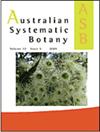A phylogenetic investigation of the taxonomically problematic Eucalyptus odorata complex (E. section Adnataria series Subbuxeales): evidence for extensive interspecific gene flow and reticulate evolution
IF 1.6
3区 生物学
Q4 EVOLUTIONARY BIOLOGY
引用次数: 2
Abstract
ABSTRACT To investigate the relationships among species in the taxonomically problematic Eucalyptus odorata species complex, we generated molecular data using double-digest restriction site-associated DNA sequencing (ddRADseq) and Diversity Arrays Technology sequencing (DArTseq). These data were analysed utilising principal-component analysis (PCA), phylogenetic networks, phylogeny reconstruction and hybridisation tests. Twelve species that are variously recognised in the complex were sampled from across their ranges, along with co-occurring members of E. section Adnataria, to allow for patterns of hybridisation and gene flow to be identified. Despite the large genetic datasets generated, many relationships within the E. odorata complex were poorly resolved, and few species were monophyletic, likely owing to both biological factors including recent speciation and extensive hybridisation and introgression, and potential over-splitting of taxa. We show that multiple taxa with limited distributions are the result of reticulate evolutionary events and that typical Eucalyptus viridis R.T.Baker and the possibly con-specific E. aenea K.D.Hill are sister to the rest of the complex. The remaining species appeared to represent a discontinuous crescent-shaped cline running from the Flinders Ranges to the south-western slopes region of New South Wales, with limited support for an east–west split in this cline across the Murray River Basin. Eucalytpus viridis var. latiuscula Blakely, which is not closely related to the typical variety of this species in our data, may represent a northern extension to this cline.有分类学问题的气味桉复合体(E.节Adnataria系列Subbuxeales)的系统发育研究:广泛种间基因流动和网状进化的证据
摘要为了研究有分类学问题的气味桉物种复合体中物种之间的关系,我们使用双消化限制性位点相关DNA测序(ddRADseq)和多样性阵列技术测序(DArSeq)生成了分子数据。利用主成分分析(PCA)、系统发育网络、系统发育重建和杂交测试对这些数据进行了分析。从不同的范围内对12个在复合体中被不同识别的物种进行了采样,以及Adnataria E.部分的共有成员,以确定杂交模式和基因流动。尽管生成了大量的遗传数据集,但气味E.odorata复合体中的许多关系都没有得到很好的解决,很少有物种是单系的,这可能是由于生物因素,包括最近的物种形成和广泛的杂交和渐渗,以及分类群的潜在过度分裂。我们表明,分布有限的多个分类群是网状进化事件的结果,典型的绿色桉R.T.Baker和可能具有特异性的E.aenea K.D.Hill是该复合体其余部分的姐妹。剩下的物种似乎代表了从弗林德斯山脉到新南威尔士州西南斜坡地区的一个不连续的新月形斜坡,对横跨默里河流域的这个斜坡的东西分裂的支持有限。在我们的数据中,与该物种的典型品种没有密切关系的绿色Eucalytpus viridis var.latinuscula Blakely可能代表了该跃层的北部延伸。
本文章由计算机程序翻译,如有差异,请以英文原文为准。
求助全文
约1分钟内获得全文
求助全文
来源期刊

Australian Systematic Botany
生物-进化生物学
CiteScore
3.10
自引率
12.50%
发文量
12
审稿时长
>12 weeks
期刊介绍:
Australian Systematic Botany is an international journal devoted to the systematics, taxonomy, and related aspects of biogeography and evolution of all algae, fungi and plants, including fossils. Descriptive taxonomic papers should normally constitute a comprehensive treatment of a group. Short papers on individual species and nomenclatural papers must contain significant new information of broader interest to be considered. The prestigious L.A.S. Johnson Review Series is published. Other review articles will also be considered. All papers are peer reviewed.
Australian Systematic Botany is published with the endorsement of the Commonwealth Scientific and Industrial Research Organisation (CSIRO) and the Australian Academy of Science.
 求助内容:
求助内容: 应助结果提醒方式:
应助结果提醒方式:


